The diagram below shows an energy pyramid for an aquatic ecosystem.
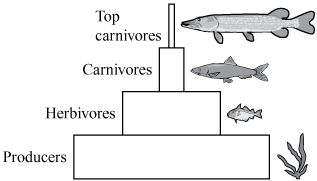
Which of the following statements best explains why the energy pyramid is narrowest at the top?
A. The organisms at the top of the pyramid are the most efficient feeders.
B. The organisms at the top of the pyramid have the largest population sizes.
C. The organisms at the top of the pyramid need only a small amount of energy for their metabolism.
D. The organisms at the top of the pyramid receive only a small fraction of the energy that originally enters the system.
Which of the following describes how a large mouse population with high genetic diversity will most likely be affected by a sudden, significant environmental change?
A. All of the individuals within the population will reproduce at a higher rate, leading to a decrease in genetic diversity.
B. New traits will arise as a result of new selective pressures in the environment, leading to an increase in genetic diversity.
C. Only those individuals best adapted to the new environment will survive and reproduce, leading to a decrease in genetic diversity.
D. Only some individuals will develop traits to help them survive in the new environment, leading to an increase in genetic diversity.
The diagram below represents a pair of homologous chromosomes in a diploid cell, and the resulting chromosome in a haploid cell. The letters represent alleles of genes.
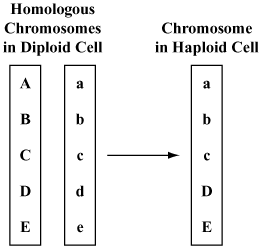
Why does the chromosome in the haploid cell have alleles from both of the chromosomes in the diploid cell?
A. Crossing over occurred during meiosis.
B. A mutation occurred during a viral infection.
C. Independent assortment occurred during fertilization.
D. Incomplete dominance occurred during gene expression.
A simple diagram of a DNA molecule is shown below.
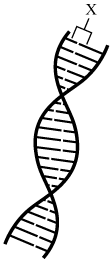
Which of the following is represented by X?
A. an amino acid
B. an mRNA bond
C. a nucleotide base pair
D. a ribosome binding site
Information is detected by the eye and sent to the brain by which of the following structures?
A. blood vessels
B. sensory neurons
C. smooth muscle
D. spinal cord
In 1937, two male and six female ring-necked pheasants were introduced to an island off the coast of Washington state. The pheasants mainly ate wheat. The only known predators on the island were house cats, hawks, and owls. After five years, the pheasant population on the island had increased to 1,325 individuals. The population size then remained stable.
Which of the following most likely explains why the pheasant population size remained stable after five years?
A. The hawks learned to hunt only owls.
B. A limited amount of wheat grew on the island.
C. All the house cats that lived on the island died.
D. The original male and female ring-necked pheasants died.
Marsupials are a type of mammal found on the continent of Australia. Marsupials are hypothesized to have descended from an ancestral marsupial species, as represented by the diagram below.
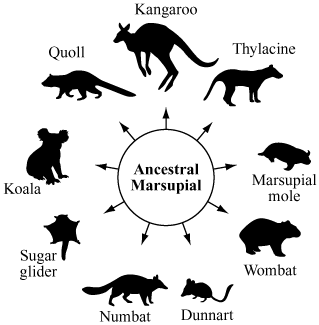
Which of the following conditions most likely caused the ancestral marsupial species to diversify into the many modern-day marsupial species found in Australia?
A. a variety of predators
B. hot climate conditions
C. a variety of environments
D. little competition for resources
Mammals store extra glucose in the form of a compound called glycogen. Which molecule supplies the energy needed to join glucose molecules together to form a molecule of glycogen?
A. ATP
B. RNA
C. oxygen
D. carbon dioxide
Which of the following describes how DNA determines genetic inheritance?
A. A single nucleotide codes for a genetic trait.
B. A pair of complementary nucleotides codes for a genetic trait.
C. A set of three nucleotides in a specific order codes for a genetic trait.
D. A long sequence of nucleotides in a specific order codes for a genetic trait.
S. epidermidis can sometimes infect wounds. The symptoms of the infection include swelling, pain, pus, skin that is warm to the touch, and redness at the infection site.
Based on the symptoms, which of these human body systems work together to restore homeostasis?
A. circulatory system and immune system
B. immune system and reproductive system
C. skeletal system and respiratory system
D. respiratory system and nervous system
African birds called honeyguides eat beeswax. Most bees’ nests are inside hollow trees where the honeyguides cannot reach them. The honeyguides lead honey badgers, which also eat beeswax, to bees’ nests. The honey badgers then dig out and eat the nests, leaving scraps of wax and honey for the honeyguides.
The relationship between the honeyguides and the honey badgers is an example of
A. commensalism.
B. competition.
C. mutualism.
D. predation.
In Florida, mice that live on the white sands of the barrier islands tend to be lighter in color than mice that live in the vegetation on the mainland. Which of the following statements describes how mice on the barrier islands most likely evolved their light coat color through natural selection?
A. The light-colored mice were easier prey for birds than the dark-colored mice.
B. The light-colored mice learned to shed more of their fur than the dark-colored mice.
C. The light-colored mice had a greater reproductive advantage on the barrier islands than the dark-colored mice.
D. The light-colored mice migrated from the mainland to the barrier islands more recently than the dark-colored mice.
In the ocean, some bacteria break down oil instead of glucose for energy. There is often a low concentration of oxygen in the areas where these bacteria are found.
Which of the following statements best explains why the oxygen concentration is often low where these bacteria are found?
A. The bacteria develop cell nuclei in the presence of the oil.
B. The bacteria perform a process similar to photosynthesis with the oil.
C. The bacteria use oxygen and release carbon dioxide as they break down the oil.
D. The bacteria make their membranes more permeable to oxygen as they break down the oil.
In humans, one form of night blindness is an inherited condition that affects far more males than females. Males with one copy of the allele for this form of night blindness will have the condition, but females must have two copies of the allele to have the condition.
Which of the following best describes the allele that codes for this form of night blindness?
A. recessive on the X chromosome
B. polygenic on the X chromosome
C. dominant on the Y chromosome
D. codominant on the Y chromosome
Which of the following statements best explains why malaria causes fatigue in humans?
A. Malaria destroys fat cells.
B. Malaria slows the digestive system.
C. Malaria reduces oxygen transport to cells.
D. Malaria increases activity in the nervous system.
A partial food web is shown below.
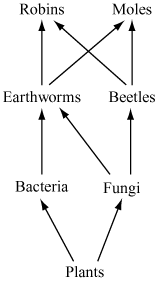
Which of the following describes the relationship between the earthworms and the beetles in the food web?
A. The earthworms and the beetles both compete for fungi.
B. The earthworms and the beetles both compete for robins and moles.
C. The earthworms help the beetles survive, and the beetles do not harm the earthworms.
D. The earthworms help the beetles survive, and the beetles help the earthworms survive.
Images of the embryo and adult stages of three different organisms are shown below.
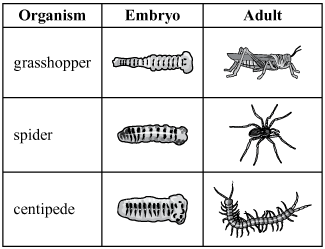
Which of the following is the best conclusion that can be drawn from this evidence?
A. Having similar embryos indicates that these organisms eat the same types of food.
B. Having similar embryos indicates that these organisms live in a similar environment.
C. Having similar embryos indicates that these organisms share a recent common ancestor.
D. Having similar embryos indicates that a certain protein controls how many legs the adult organisms will have.
Students investigated the effect of acid rain on photosynthesis. Several plants were given water with a pH of 4 each day for two months. The results showed that the plants had a reduced rate of photosynthesis.
How did the acidic water most likely reduce the plants’ rate of photosynthesis?
A. by storing excess oxygen produced by the plants
B. by changing the effectiveness of enzymes in the plants
C. by causing root hairs to grow on the roots of the plants
D. by increasing the amount of carbon dioxide taken in by the plants
A. The polypeptide will have fewer amino acids.
B. The polypeptide will have the same amino acids.
C. The polypeptide will contain a different amino acid.
D. The polypeptide will contain an additional amino acid.
A high respiratory rate usually indicates that a person’s body needs more
A. antibodies.
B. carbon dioxide.
C. oxygen.
D. platelets.
The New England cottontail is the only rabbit native to New England. Current populations are small and isolated because of habitat loss. Scientists are concerned about the possible extinction of the New England cottontail.
Which of the following statements explains why having small and isolated populations puts these rabbits at risk for extinction?
A. Diet requirements of the rabbits are changed, making the emigration rate increase.
B. Male-to-female ratios in the populations are changed, making the birth rate fall to zero.
C. Immigration is increased, making it harder for the rabbits to successfully compete for resources.
D. Genetic variation is decreased, making the populations less able to adapt to environmental changes.
Which of the following observations most strongly supports evolutionary links between fossil organisms and modern organisms?
A. The fossil organisms and modern organisms have identical body sizes.
B. The fossil organisms and modern organisms have homologous body structures.
C. The fossil organisms are hundreds of thousands of years old, and modern organisms have been around for hundreds of years.
D. The fossil organisms are found in many different rock layers, and modern organisms live in many different habitats.
Waxes form a waterproof coating over the stems and leaves of many terrestrial plants. The waxes are composed of fatty acids linked to long-chain alcohols.
Based on this information, waxes are which type of organic molecule?
A. lipids
B. nucleotides
C. polysaccharides
D. proteins
Mice with the same parents can have different traits. Which of the following best explains how most of these differences occur?
A. Gametes join by binary fission.
B. Cells divide by asexual reproduction.
C. Genes assort independently during meiosis.
D. Spontaneous mutations occur during mitosis.
Low blood pressure can be life-threatening. To help maintain a stable blood pressure, receptors in the heart detect changes in blood pressure. Information about blood pressure changes is then sent to the brain. If blood pressure is too low, the brain sends a message to the heart to beat faster. Based on this information, which of the following systems are directly involved in keeping blood pressure stable?
A. circulatory, muscular, nervous
B. circulatory, immune, skeletal
C. excretory, immune, muscular
D. excretory, nervous, skeletal